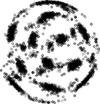You are here: Foswiki>Cosmo Web>WebPreferences>ContentOfUniverse (17 Jun 2021, BoudRoukema)Edit Attach
<< Cosmo
Content of Universe summary to be included in other pages
Density fluctuations and galaxy formation
But the Universe is not perfectly the same everywhere in space - even when the Universe was just a few hundred thousand years old, some regions were more dense and some were less dense. The more dense regions eventually collapsed under their own weight, via gravity, and formed galaxies, stars, and planets. These fluctuations are not just interesting for galaxy formation, they are also useful for measuring the curvature of space. Density fluctuations on the smaller scales (up to about 1 Mpc, a few million light-years) collapsed gravitationally, forming galaxy clusters and galaxies in which stars and planets formed. Comparing observations of galaxies and galaxy clusters to the cosmic microwave background and separating the two effects was a major theme of the observational aspects of the OCRA program using our 32m radio telescope. Upcoming major survey projects in which Toruń astronomers are involved include the Rubin Observatory (TorunLSST) and 4MOST (Torun4MOST). -- BoudRoukema - 05 Nov 2015Edit | Attach | Print version | History: r3 < r2 < r1 | Backlinks | View wiki text | More topic actions
Topic revision: r3 - 17 Jun 2021, BoudRoukema
 Copyright © by the contributing authors. All material on this collaboration platform is the property of the contributing authors.
Copyright © by the contributing authors. All material on this collaboration platform is the property of the contributing authors. Ideas, requests, problems regarding Foswiki? Send feedback
